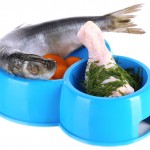Choosing a Quality Dog Food
 Choosing a quality dog food will ensure that your pet is getting the proper nutrition.
Choosing a quality dog food will ensure that your pet is getting the proper nutrition.
If you had 5 cups of coffee and a dozen donuts for your daily meal, would you feel a bit off-balance? If you ate this every day, how would it affect your health, energy level and behavior? Most dog owners don’t realize that many dog food brands are nutritionally equivalent to the coffee and donut scenario.
Why is good nutrition important?
Proper nutrition results in a healthier coat, stronger bones and muscles, and healthy vital organs. Healthy ingredients in a dog food result in fewer digestive and allergy complications, less intestinal gas and firmer and fewer stools. Mood and behavior are also affected by food intake- the better the food, the better the behavior.
Pay attention to ingredients and their order on dog food labels
On food labels, ingredients are listed in order of the total percentage of their weight before processing. The first ingredient listed has the heaviest weight; the second ingredient is the second highest weight in the recipe and so on. But here’s where it gets tricky. If a named meat such as deboned turkey, pork or deboned chicken is listed, the water weight of these products must be considered. Meat has a high water content, which will evaporate out of the food during the cooking and drying process. As a result, the amount of meat that is left in the finished product may not be the highest amount of all ingredients.
 The first ingredient in your dog’s food should be a specifically named protein, such as chicken or salmon. Meat by-products (also known as meat or bone meal, by-product meal, animal by-product, chicken by-product, etc) are not the same as meat. They are the leftovers of slaughter once the meat has been removed and can include some undesirable things.
The first ingredient in your dog’s food should be a specifically named protein, such as chicken or salmon. Meat by-products (also known as meat or bone meal, by-product meal, animal by-product, chicken by-product, etc) are not the same as meat. They are the leftovers of slaughter once the meat has been removed and can include some undesirable things.The second ingredient in your dog’s food should be a meat meal. To accommodate for the loss of water in meat, manufactures add meat meals for added protein and nutrients. The word “meal” is used to describe a powder rendered from meat, bone, skin, chicken frames, etc. Why is this important? Fresh meat contains 15-25% protein and 65-75% water. “Meals” contain about 10% water and 65-70% protein. The inclusion of fresh meat adds to palatability for the dog, the inclusion of meal typically provides the necessary protein.
Healthy Veggies and Fruits– Whole cooked vegetables are nutrient”“rich and easy to digest. Vegetables are important because they are a great source of antioxidants, which are essential to your dog’s good health. Whole fruits are healthy but experts disagree as to their necessity in a dog’s diet.
Preservatives– Two particular preservatives to avoid are “BHA” (Butylated Hydroxyanisole) and “BHT” (Butylated Hydroxytoluene). Research shows that these chemicals have caused cancer in laboratory animals. Natural preservatives such as vitamin C (ascorbic acid) and vitamin E (tocopherols) are much safer and healthier.
Dog Food Manufacturers – Who can you trust?
We are inundated with marketing messages, misleading words on product packaging, and ingredient terminology that we don’t understand. Being an educated consumer is critical to ensuring your pet’s health and the integrity of their food. You should only trust yourself by doing your own research on brands you are considering.
- Read your pet food label/ingredient list to familiarize yourself with the contents. How do the ingredients look to you?
- If you are unfamiliar with an ingredient, look it up so that you can make informed choices. Two reference sites specific for this purpose are included at the end of this article.
- Refer to manufacturers’ websites, brochures and claims on their dog food bags and compare them to the actual ingredient list. Don’t be afraid to contact a manufacturer and ask questions. Just remember, it is your responsibility to validate the information they give you.
Do your own feeding trial
The highest quality food will not be beneficial if your dog won’t eat it. Most manufacturers offer trial size bags. Select several brands that have passed your research test and see how your dog responds to them. Virtually all manufacturers allow you to return unused portions to your place of purchase if your dog does not like the food.
How much to feed your dog
Always use the manufacturer’s guidelines to calculate how much to feed your dog. The nutritional value of each recipe directly affects the quantity your dog needs in order to meet the recommended daily allowance. By the way, if you’re worried about the cost of good food, keep this in mind- the better the food, the less of it you will have to feed.
Resources
©Paws in Training, 2011
The goal of all dog training is to provide peaceable solutions to everyday problems so that pets and their owners live harmoniously. Paws in Training provides dog and cat training services in Raleigh, Apex, Holly Springs, Cary, Fuquay Varina and Garner, N.C.

